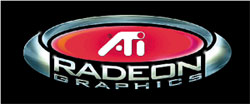Introduction
 A
lot has changed at ATI since its formation in 1985. Long gone are the days when
a complex graphics chip had 10,000 transistors and 3D rendering was a thing
of science fiction. No longer can ATI release a product when it sees fit or
lavish in the quality of their 2D features. No, the world of consumer graphics
cards has become a constantly changing and adopting field of electronics, making
it a very fast paced and dog-eat-dog world.
A
lot has changed at ATI since its formation in 1985. Long gone are the days when
a complex graphics chip had 10,000 transistors and 3D rendering was a thing
of science fiction. No longer can ATI release a product when it sees fit or
lavish in the quality of their 2D features. No, the world of consumer graphics
cards has become a constantly changing and adopting field of electronics, making
it a very fast paced and dog-eat-dog world.
Due to this, any video card company must adapt to the changing times. In many instances unsuccessful, we have seen the fall of great companies that are the foundation of today's technology. Unlike these companies, however, ATI has continued to thrive, at least from a business standpoint. In addition to their adaptation to the changing landscape of the consumer graphics market, ATI has adapted to changes in a vast range of computing fields, from set-top boxes to home entertainment, making it one of the largest image companies in the world.
With all the success that ATI has encountered in the past, there have been recent downfalls. Products such as the Rage128 were plagued with not only delayed releases but poor drivers. "High end" products, such as the Rage Furry MAXX, found themselves paired up with much better performing products from the competitors as a result of these delays. This poor track record was enough to keep the power computer user away from ATI, but good relations ensured ATI's success in the OEM market.
The poor driver support and delayed products marked a dramatic change from ATI's initial reputation. Changing from a consumer target to an OEM pleaser was exactly the opposite of what ATI needed to do in order to stay afloat in the competitive field of consumer graphics. Just as the doctor ordered, times seem to be changing for ATI again, this time for the better.
ATI's new approach to the 3D graphics card market was initially displayed with the Rage6C core. The announcement of this core in April at WINHEC was customary of the typical ATI announcement with many promises made. Once again as a product of ATI's poor track record, people assumed that a card based on the Rage6C would be at least 3 or 4 months delayed from the expected release date of August, emerging well in the turf of NVIDIA's upcoming NV20. However, with cards shipping to retail locations by the time you read this and ATI preaching a 6 month new product cycle, even John Carmack is talking about ATI's Radeon card; and when Carmack is talking, the whole industry is talking.










2 Comments
View All Comments
Thatguy97 - Tuesday, May 5, 2015 - link
ahh i remember anadtechs jihad against atiwow im dating myself
Frumious1 - Monday, August 29, 2016 - link
I don't remember it at all. The only thing I recall is a bunch of whiny ass fanboys complaining when their chosen CPU, GPU, etc. didn't get massive amounts of acclaim. The very first Radeon cards were good, but they weren't necessarily superior to the competition. You want a good Radeon release, that would be the 9700 Pro and later 9800 Pro -- those beat Nvidia hands down, and AnandTech said as much.